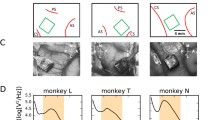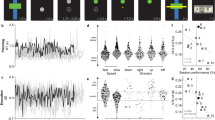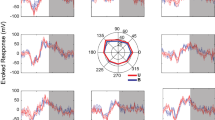Abstract
Local field potentials (LFPs) measure aggregate neural activity resulting from the coordinated firing of neurons within a local network. We hypothesized that state parameters associated with the underlying brain dynamics may be encoded in LFPs but may not be directly measurable in the signal temporal and spectral contents. Using the Kalman filter we estimated latent state changes in LFPs recorded in monkey motor cortical areas during the execution of a visually instructed reaching task, under different applied force conditions. Prior to the estimation, matched filtering was performed to decouple behavior-relevant signals (Stamoulis and Richardson, J Comput Neurosci, 2009) from unrelated background oscillations. State changes associated with baseline oscillations appeared insignificant. In contrast, state changes estimated from LFP components associated with the execution of movement were significant. Approximately direction-invariant state vectors were consistently observed. Their patterns appeared invariant also to force field conditions, with a peak in the first 200 ms of the movement interval, but exponentially decreasing to the zero state approximately 200 ms from movement onset, also the time at which movement velocity reached its peak. Thus, state appeared to be modulated by the dynamics of movement but neither by movement direction nor by the mechanical environment. Finally, we compared state vectors estimated using the Kalman filter to the basis functions obtained through Principal Component Analysis. The pattern of the estimated state vector was very similar to that of the first PCA component, further suggesting that LFPs may directly encode brain state fluctuations associated with the dynamics of behavior.








Similar content being viewed by others
References
Baker, S. N., Kilner, J. M., Pinches, E. M., & Lemon, R.N. (1999). The role of synchrony and oscillations in the motor output. Experimental Brain Research, 128, 109–117.
Dempster, A. P., Laird, N. M., & Rubin, D. B. (1977). Maximum likelihood from incomplete data via th EM algorithm. Journal of the Royal Statistical Society, Series B, 39(1), 1– 38.
Garvasoni, D., Lin, S. C., Ribieiro, S., Soares, E. S., Pantoja, J., & Nicolelis, M. A. L. (2004). Global forebrain dynamics predict rat behavioral states and their transitions. Journal of Neuroscience, 24(49), 11137–11147.
Hatsopoulos, N. G., et al. (2006). Decoding continuous and discrete motor behaviors using motor and premotor cortical ensembles. Journal of Neuroscience, 96, 1658–1663.
Kalman, R. E. (1960). A new approach to linear filtering and prediction problems. Transactions of the ASME-Journal of Basic Engineering, 82(Series D), 35–45.
Katzner, S., Nauhaus, I., Benucci, A., Bonin, V., Ringach, D. L., & Carandini, M. (2009). Local origin of field potentials in visual cortex. Neuron, 61, 35–41.
Kemere, C., Santhanam, G., Yu, B. M., Afshar, A., Ryu, S. I., Meng, T. H., et al. (2008). Detecting neural-state transitions using hidden Markov models for motor cortical prostheses. Journal of Neuroscience, 100, 2441–2452.
Lin, S. C., & Gervasoni, D. (2008). Defining global brain states using multi-electrode field potential recordings. In M. Nicolelis (Ed.), Frontiers in neuroscience: methods for neural ensemble recordings (Ch. 8). Boca Raton: CRC Press.
Lopes da Silva, F. H. (1991). Neural mechanisms underlying brain waves: From neural membranes to networks, Electroencephalography and Clinical Neurophysiology, 79, 81–93.
Murthy, V. N., & Fetz, E. E. (1996). Oscillatory activity in sensorimotor contex of awake monkeys: Synchronization of local field potentials and relation to behavior. Journal of Neurophysiology, 76(6), 3849–3967.
Olsson, R. K., Petersen, K. B., & Lehn-Schioler, T. (2007). State-space models: From the EM algorithm to a gradient approach. Neural Computation, 19, 1097–1111.
Richardson, A. G. (2007). Role of the precentral cortex in adapting behavior to different mechanical environments. Ph.D. thesis, Massachusetts Institute of Technology.
Rickert, J., et al. (2005). Encoding of movement direction in different frequency ranges of motor cortical local field potentials. Journal of Neurophysiology, 25(3), 8815–8824.
Roux, S., et al. (2006). The pre-movement component of motor cortical local field potentials reflects the level of expectancy. Behavioural Brain Research, 169, 335–351.
Sanes, J. N., & Donoghue, J. P. (1993). Oscillations in local field potentials of the primate motor cortex during voluntary movement. Proceedings of the National Academy of Sciences of the United States of America, 90, 4470–4474.
Smith, A. C., & Brown, E. N. (2003). Estimating a state-space model from point process observations. Neural Computation, 15, 965–991.
Srinivasan, L., Eden, U., Mitter, S. K., & Brown, E. N. (2007). General-purpose filter design for neural prosthetic devices. Journal of Neurophysiology 98, 2456-2475
Stamoulis, C., & Richardson, A. G. (2009). Application of matched filtering to identify behavioral modulation of brain oscillations. Journal of Computational Neuroscience (in press).
Author information
Authors and Affiliations
Corresponding author
Additional information
Action Editor: Simon Schultz
This work was supported in part by NIH grants 5T32NS048005-05 and 1UL1RR025758-01 (CS) and NS-044393 (AR).
Rights and permissions
About this article
Cite this article
Stamoulis, C., Richardson, A.G. Encoding of brain state changes in local field potentials modulated by motor behaviors. J Comput Neurosci 29, 475–483 (2010). https://doi.org/10.1007/s10827-010-0219-6
Received:
Revised:
Accepted:
Published:
Issue Date:
DOI: https://doi.org/10.1007/s10827-010-0219-6




